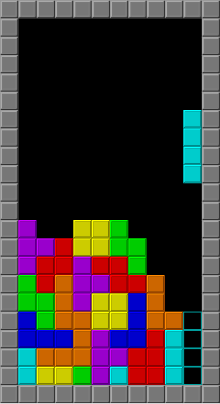
Back Tetris Afrikaans ቴትሪስ Amharic Tetris AN تتريس Arabic Tetris AST Tetris Azerbaijani Tétris BAN Тэтрыс Byelorussian Тэтрыс BE-X-OLD Тетрис Bulgarian
| Tetris | |
|---|---|
 A typical Tetris game screen | |
| Designer(s) | Alexey Pajitnov |
| Platform(s) | List of Tetris variants |
| Release | IBM PC DOS |
| Genre(s) | |
| Mode(s) | |
Tetris (Russian: Тетрис[a]) is a puzzle video game created in 1985 by Alexey Pajitnov, a Soviet software engineer.[1] It has been published by several companies on more than 65 platforms, setting a Guinness world record for the most ported game. After a significant period of publication by Nintendo, in 1996 the rights reverted to Pajitnov, who co-founded the Tetris Company with Henk Rogers to manage licensing.
In Tetris, players complete lines by moving differently shaped pieces (tetrominoes), which descend onto the playing field. The completed lines disappear and grant the player points, and the player can proceed to fill the vacated spaces. The game ends when the uncleared lines reach the top of the playing field. The longer the player can delay this outcome, the higher their score will be. In multiplayer games, players must last longer than their opponents; in certain versions, players can inflict penalties on opponents by completing a significant number of lines. Some versions add variations such as 3D displays or systems for reserving pieces.
Tetris is often named one of the greatest video games. By December 2011, it had sold 202 million copies—approximately 70 million physical units and 132 million paid mobile game downloads—making it one of the best-selling video game franchises. The Game Boy version is one of the best-selling games of all time, with more than 35 million copies sold. Imagery from the game has influenced architecture, music, and cosplay. Tetris has also been the subject of various studies that have analyzed its theoretical complexity and have shown its effect on the human brain following a session, in particular the Tetris effect.
Cite error: There are <ref group=lower-alpha> tags or {{efn}} templates on this page, but the references will not show without a {{reflist|group=lower-alpha}} template or {{notelist}} template (see the help page).
- ^ "Tetris | video game | Britannica". www.britannica.com. Archived from the original on April 29, 2024. Retrieved April 18, 2023.